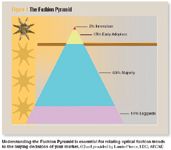Article
$26.6B Pyramid
When optical dispensing professionals look at frame fashion trends and discuss them with our patients/clients, it is essential to have a perspective on where we have been, where we are today, and where we are going.

Key Points
Flash back 20 years ago. It was the era of Max Headroom, New Kids on the Block, the TRS-80 computer, "The $25,000 Pyramid" . . .
Adjust your focus on the fashions of 20 years ago-the Preppy look, the Flashdance look, the Valley Girl look ...
Now zero in on frame fashions 20 years ago. We had three color choices-gold, silver, gunmetal-and three style options-ugly, uglier, ugliest.
How did we get here?
When optical dispensing professionals look at frame fashion trends and discuss them with our patients/clients, it is essential to have a perspective on where we have been, where we are today, and where we are going.
Optical fashionistas have been trying for years to redirect eyewear from the medical device category to the realm of functional fashions. For those of us who have been in the optical dispensing profession during that time and have longed for the day when our specialty might make the fashion radar, we have arrived.
Want proof? As of March 2008, the retail value of the industry (excluding contact lens sales) is $26.6 billion. [Source: VisionWatch.] Take a look around you. Upscale department stores, glossy fashion magazines, movie stars on the big screen ... Interest in eyewear fashion is gaining momentum. Just recently, on a shopping spree with a friend, we noticed a display of new designer sunglasses. They were non-Rxable, did not have polarized lenses, and retailed for $425 per pair. My friend wanted to buy a second pair, but the sales representative had to order it because the shop was selling off the shelf. Make no mistake, strong fashion names (e.g., Chanel, Prada, and Dolce and Gabbana) have a following and consumers will spend additional dollars on what they want versus what they need:
Communicating the difference between consumer wants and consumer needs requires knowledge of the latest and greatest eyewear trends of the day.
But, how do we know the latest and greatest trends? How do we translate these trends into functional, viable, usable prescription eyewear? How do we answer questions in regard to 'what's new?'
A great way to get a handle on current optical fashion trends is to look around you. Flip through fashion magazines, surf the Internet, and visit high-end department stores such as Saks, Neiman Marcus, and-the mother ship-Nordstrom. Those retailers understand fashion trends and demands, and will give us clues with their layout, style, and color offerings.
Recommend the trend
The best way to recommend eyewear fashions with confidence is to recognize fashion trends, and then match the trends appropriately with your patient/client demographics.

Newsletter
Don’t miss out—get Ophthalmology Times updates on the latest clinical advancements and expert interviews, straight to your inbox.




